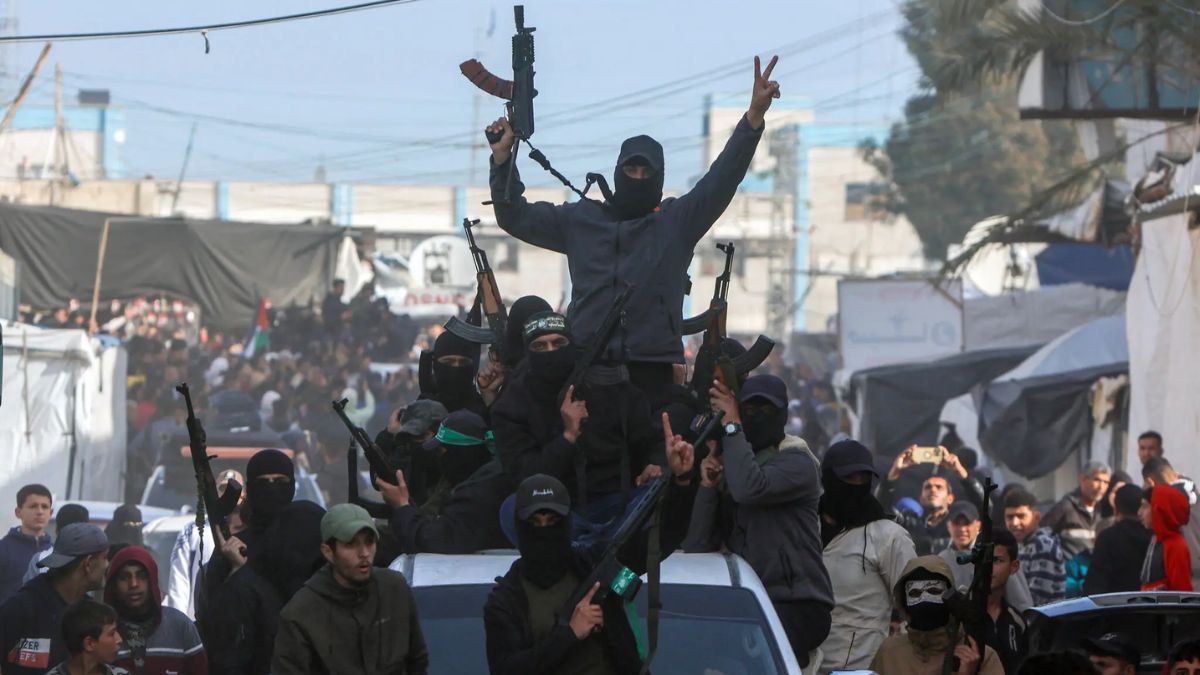Hamas has been using the release of hostages as an opportunity to rebuild itself and assert its authority in the Gaza Strip, according to Israel’s assessment.
Shortly after the Israel-Hamas ceasefire came into effect in Gaza on January 19, Hamas personnel emerged from hiding to drive through the Palestinian enclave in a show of force. Since then, every time hostages have been released, Hamas terrorists have been present at the site in large numbers.
Last week, the hostage release was so chaotic that hundreds of Gazans, including dozens of armed Hamas terrorists, mobbed hostages and forced Israel to formally register protest and delay the release of Palestinian prisoners — Hamas is releasing hostages in lieu of around 1,000 Palestinians held in Israeli jails.
The Israeli assessment, reported by The Daily Telegraph, is in line with reports from Gaza that say that Hamas returned to the streets as the de facto rulers of the Palestinian enclave. Even though the war has degraded Hamas’ war-waging capabilities, it has returned since the beginning of the ceasefire to resume governance operations, such as policing, medical services, and civic services.
How Hamas is using hostage-release to its benefit
Hamas is using hostage-release to regroup its members and map Gaza with drones to assess the lay of the land, Israeli sources told The Telegraph.
Ronen Solomon, a senior intelligence analyst, told the newspaper that armed personnel are increasing at every hostage-release.
“We can see patterns of progress of the force of Hamas from ceremony to ceremony. By using these events, we can see that from a small force, each time they make it bigger, from a platoon to more like a brigade operation. We can see more soldiers each time, from 20 to 150 fighters with weapons, [and] more pick-up trucks like they used on Oct 7,” said Solomon.
Impact Shorts
More ShortsSeparately, a senior intelligence figure told The Telegraph that Hamas has put Israel in a tight spot and “is definitely taking advantage of these events to regroup”.
“Hamas has us on a tightrope because we don’t wish to give them a pretext to withdraw from the swap, but they are definitely taking advantage of these events to regroup,” said the intelligence figure.
By holding hostage-release ceremonies at different locations, Hamas is ensuring show of strength in all quarters of Gaza and is also using the opportunity to map Gaza, learning the scope of the destruction and how Israel is deployed in the strip. As the war pushed Hamas out of several places in Gaza and pushed it underground in many places, it has a limited understanding of the situation on the ground and Solomon said the hostage-release is allowing Hamas to overcome the barrier.
“Yes, Hamas is filming the hostage swap with the drones but they’re also collecting geographic information on the area and Israel can’t do anything about it while there is a ceremony. Each time they’re changing the location of the handover, so they’re mapping Gaza, Rafah, Khan Younis, Gaza Port, so they’re building the intelligence,” said Solomon.
Hamas is degraded but it’s back nonetheless
Even though Hamas is back, Israeli sources appear to be downplaying the resurgence.
While the United States has said that Hamas has recruited as many terrorists as Israel has killed in the war , a senior military source told The Telegraph that only a few hundred new, young, and inexperienced recruits have been taken on by Hamas in place of around 17,000 Hamas personnel killed in the war.
The source further said that Israel had imposed a “serious degradation” on Hamas’ military capabilities.
Irrespective of whatever Israeli sources are saying, the fact is that Hamas is back in Gaza as a force and has taken up functions of governance that it had before the war broke out during the October 7 attack — Hamas had been running Gaza since 2007.
As soon as the ceasefire came into effect in Gaza, Hamas personnel turned up with rifles, Hamas flags, and vehicles in Gaza’s cities and drove around in a show of force. Since then, Hamas’ government apparatus has made a comeback : Hamas-run police have returned to the streets, Hamas-run municipalities have resumed civic services, Hamas-run health authorities have taken charge of healthcare services, and Hamas is also part of the security screening at Netzarim Corridor of displaced Palestinians returning to their homes in northern Gaza.
Gen. Mahmoud Abu Watfa, a senior official in the Hamas-run Gazan interior ministry, has toured the enclave amid armed police personnel to show who is in charge.
“The picture is clear. The ones controlling security, protecting citizens and safeguarding the internal front are the forces of the Interior Ministry,” said Watfa, according to The New York Times.
Michael Milshtein, a former military intelligence analyst specialising in Palestinian affairs, told The Times that Hamas is much weaker than it was before the war but it’s “totally clear that it can impose its sovereignty everywhere in Gaza”.
)